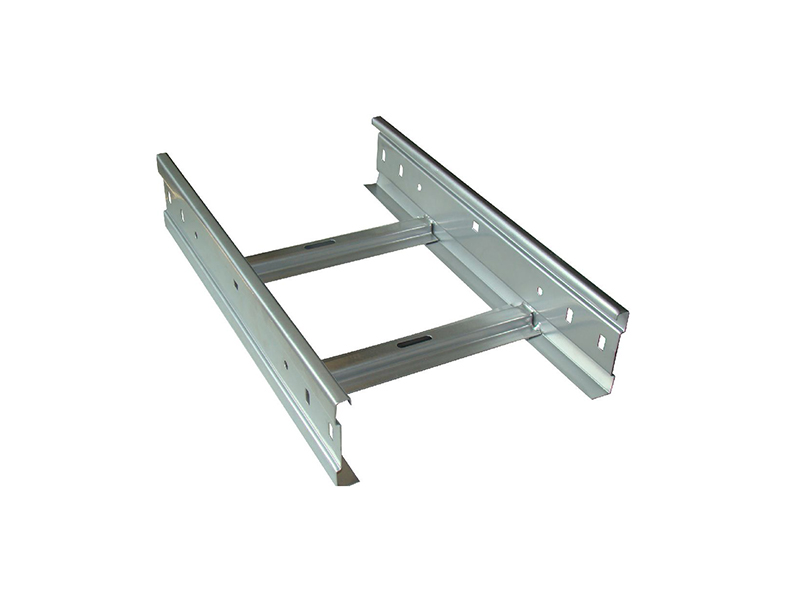济南苏鑫电缆桥架有限公司
客户咨询热线
0531-85767688
售后热线:15668327566
联系基地:山东省 德州市协同发展产业园D06幢
文章来源:https://www.sddlqj.cn/ 作者:电缆桥架厂家发布时间:2025-07-25 浏览次数:1
在电缆桥架的防腐处理工艺中,热浸锌与热镀锌是两种常见的镀锌方式,虽名称相似,但在工艺原理、防腐性能及适用场景上存在显著差异。了解两者的区别,有助于根据实际环境需求选择更适配的桥架,避免因防腐失效导致的隐患与维护成本增加。
In the anti-corrosion treatment process of cable trays, hot-dip galvanizing and hot-dip galvanizing are two common galvanizing methods. Although they have similar names, there are significant differences in process principles, anti-corrosion performance, and applicable scenarios. Understanding the difference between the two can help choose a more suitable bridge frame based on actual environmental needs, avoiding safety hazards and increased maintenance costs caused by anti-corrosion failure.
工艺原理的不同是两者本质的区别,直接影响镀锌层的形成方式与结构。热浸锌工艺是将除锈后的桥架浸入融化的锌液(温度约 440-460℃)中,使桥架表面与锌液发生化学反应,形成一层锌铁合金层,外层再覆盖纯锌层,整体镀层由内到外呈现 “铁 - 锌合金层→锌层” 的梯度结构,镀层厚度通常为 60-120 微米。这一过程中,锌液与基体金属的充分浸润让镀层与桥架结合极为紧密,用坚硬物体划刻镀层时,镀层不易剥落,能随基体轻微变形而不破裂。
The difference in process principles is the most fundamental difference between the two, which directly affects the formation method and structure of the galvanized layer. The hot-dip galvanizing process involves immersing the rust removed bridge into a molten zinc solution (at a temperature of approximately 440-460 ℃), causing a chemical reaction between the surface of the bridge and the zinc solution to form a layer of zinc iron alloy. The outer layer is then covered with a pure zinc layer, and the overall coating presents a gradient structure from the inside out, with a coating thickness typically ranging from 60-120 microns. During this process, the sufficient infiltration of zinc solution and substrate metal makes the coating and bridge tightly bonded. When carving the coating with a hard object, it is not easy to peel off and can withstand slight deformation of the substrate without breaking.
热镀锌工艺(又称电镀锌)则是通过电解作用实现,将桥架作为阴极放入锌盐溶液中,阳极挂锌板,通直流电后锌离子在桥架表面沉积形成纯锌镀层,镀层厚度较薄,通常为 10-30 微米,且为单一的纯锌层结构,与基体的结合力主要依靠物理吸附,划刻时容易出现镀层起皮现象。工艺温度方面,热浸锌需在高温下进行,而热镀锌在常温溶液中完成,对桥架基体的热影响更小,适合对精度要求较高的薄壁桥架。
The hot-dip galvanizing process (also known as electroplating) is achieved through electrolysis. The bridge is placed as the cathode in a zinc salt solution, and a zinc plate is hung on the anode. After direct current is applied, zinc ions deposit on the surface of the bridge to form a pure zinc coating. The coating thickness is relatively thin, usually 10-30 microns, and it is a single pure zinc layer structure. The bonding force with the substrate mainly relies on physical adsorption, and peeling of the coating is prone to occur during engraving. In terms of process temperature, hot-dip galvanizing needs to be carried out at high temperatures, while hot-dip galvanizing is completed in a room temperature solution, which has less thermal impact on the bridge substrate and is suitable for thin-walled bridge structures with high precision requirements.
防腐性能的差异源于镀层结构与厚度的不同,决定了两者在不同环境下的耐用性。热浸锌桥架因镀层厚且含锌铁合金层,防腐能力显著优于热镀锌桥架。在潮湿环境(如地下车库、地下室)中,热浸锌镀层能通过锌的牺牲阳极作用,缓慢消耗自身保护基体,使用寿命可达 15-20 年;而热镀锌桥架在相同环境下,由于镀层薄,3-5 年就可能出现局部锈蚀。
The difference in anti-corrosion performance is due to the difference in coating structure and thickness, which determines their durability in different environments. Hot dip galvanized bridge has significantly better anti-corrosion ability than hot-dip galvanized bridge due to its thick coating and zinc iron alloy layer. In humid environments such as underground garages and basements, hot-dip zinc coatings can slowly consume their protective substrate through the sacrificial anodic effect of zinc, with a service life of up to 15-20 years; However, hot-dip galvanized cable trays may experience localized corrosion within 3-5 years due to thin coating in the same environment.
在工业环境(如化工车间、印染厂)中,热浸锌的厚镀层能更好地抵御空气中的腐蚀性气体(如二氧化硫、氯气)侵蚀,镀层表面形成的致密氧化膜可阻隔腐蚀介质渗透;热镀锌桥架的薄镀层则易被腐蚀气体穿透,导致基体生锈。对于户外暴露场景(如露天电缆沟、路灯桥架),热浸锌桥架能承受雨水冲刷、紫外线照射及温度变化的考验,而热镀锌桥架在长期户外环境中,镀层易因氧化出现粉化脱落,防腐寿命仅为热浸锌的 1/3-1/2。
In industrial environments such as chemical workshops and printing and dyeing factories, hot-dip galvanized thick coatings can better resist the erosion of corrosive gases (such as sulfur dioxide and chlorine gas) in the air. The dense oxide film formed on the surface of the coating can block the penetration of corrosive media; The thin coating of hot-dip galvanized cable trays is easily penetrated by corrosive gases, causing rusting of the substrate. For outdoor exposure scenarios such as cable trenches and street lamp trays, hot-dip galvanized trays can withstand the test of rainwater erosion, ultraviolet radiation, and temperature changes. However, hot-dip galvanized trays are prone to powdering and peeling of the coating due to oxidation in long-term outdoor environments, and their anti-corrosion life is only 1/3-1/2 of hot-dip galvanized trays.

适用场景的分化由性能与成本共同决定,需结合环境腐蚀性与经济预算选择。热浸锌桥架适合高腐蚀性、长期户外或潮湿的重负荷场景,如沿海地区(高盐雾)、污水处理厂(高湿度、含硫化氢)、冶金车间(高温、粉尘多)等,虽然初期采购成本较高(约为热镀锌桥架的 1.5-2 倍),但长期使用无需频繁更换,综合成本更低。
The differentiation of applicable scenarios is determined by both performance and cost, and needs to be combined with environmental corrosiveness and economic budget selection. Hot dip galvanized cable trays are suitable for highly corrosive, long-term outdoor or humid heavy load scenarios, such as coastal areas (high salt spray), sewage treatment plants (high humidity, hydrogen sulfide), metallurgical workshops (high temperature, high dust), etc. Although the initial procurement cost is relatively high (about 1.5-2 times that of hot-dip galvanized cable trays), long-term use does not require frequent replacement, and the overall cost is lower.
热镀锌桥架则适用于干燥、腐蚀性弱的轻负荷环境,如办公楼、的室内电缆竖井,普通厂房的干燥区域等,其较低的成本与较薄的镀层(对桥架重量影响小)更具优势。在对外观要求较高的场合(如展厅、酒店大堂),热镀锌桥架表面更光滑平整,经钝化处理后可呈现银白色或彩色外观,而热浸锌桥架表面因高温反应会形成略带粗糙的银灰色,视觉效果相对朴素。
Hot dip galvanized cable trays are suitable for dry and weakly corrosive light load environments, such as indoor cable shafts in office buildings and shopping malls, and dry areas in ordinary factories. Their lower cost and thinner coating (which has less impact on the weight of the cable tray) are more advantageous. In occasions with high requirements for appearance, such as exhibition halls and hotel lobbies, hot-dip galvanized bridge frames have a smoother and smoother surface. After passivation treatment, they can present a silver white or colored appearance, while hot-dip galvanized bridge frames may form a slightly rough silver gray surface due to high temperature reactions, resulting in a relatively simple visual effect.
安装与维护的细节差异也需纳入考量,影响施工便利性与后期管理。热浸锌桥架因镀层厚且硬度高,切割、钻孔时需使用专用工具,否则易导致切口处镀层开裂,切割后需对切口进行防腐处理(如涂刷锌含量高的防锈漆);热镀锌桥架镀层薄,加工难度低,切口处理相对简单,用普通防锈漆即可弥补镀层损伤。
The differences in installation and maintenance details also need to be taken into consideration, which affects the convenience of construction and later management. Hot dip galvanized cable trays require specialized tools for cutting and drilling due to their thick coating and high hardness. Otherwise, the coating at the cut may crack. After cutting, anti-corrosion treatment (such as applying anti rust paint with high zinc content) should be carried out on the cut; The hot-dip galvanized bridge has a thin coating, low processing difficulty, and relatively simple incision treatment. Ordinary anti rust paint can be used to compensate for the damage to the coating.
本文由山东电缆桥架友情奉献.更多有关的知识请点击:http://www.sddlqj.cn我们将会对您提出的疑问进行详细的解答,欢迎您登录网站留言.
This article is a friendly contribution from Shandong Cable Bridge For more information, please click: http://www.sddlqj.cn We will provide detailed answers to your questions. You are welcome to log in to our website and leave a message
 200山东电缆桥架能放多少根电线
200山东电缆桥架能放多少根电线
200mm宽的电缆桥架能容纳的电缆数量取决于多个因素,包括电缆类型、填充率、布置方式以及散热和维护要求。以下是关键计算要点: The number of cables that a 200mm
TIME:2025-12-19